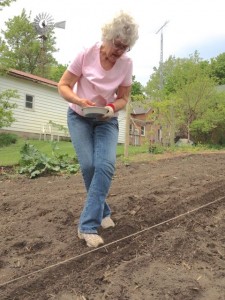My Little Bag of Beans
By Susan Shanklin
When Tom returns from his domestic travels he sometimes brings home items given to him for me or us to use, try, and enjoy. His recent trip to North Dakota produced not deer meat nor honey nor wash cloths nor desserts nor fried bread nor gladiolus like some previous trips, but an unassuming ziplock quart bag of tannish yellow dry beans with chunks of dirt, tiny stems, and leaf particles.
“Here, the pastor’s wife sent these for you,” Tom says, handing me the bean bag. “Mmmm thanks,” I say without much excitement.
“She called them Arikara beans, I think.” Joy (the pastor’s wife) said someone had given her some of the beans and she planted them the first year and saved seed from that harvest for the next year. The beans came from the Arikara Indians who at one time were almost wiped out from small pox.
My little ziplock baggie full of beans interests me now, and I of course goggle “Arikara Indians” and find that they once lived in northern South Dakota along the Missouri River and were visited by Lewis and Clark, who are said to have survived on the Arikara beans they received from them. They were mainly an agricultural people. Due to sickness, war, and displacement, the Arikara tribe ended up on the Fort Berhold Reservation in North Dakota in 1862.
I stared at my little bag of beans and saw life and hardship. I saw provision and history. I washed the beans carefully and soaked them for a day and a half, then fired up a big pot of these triple resized tannish beans with some of my frozen yellow squash, a tablespoon of tomato paste, two strips of bacon, three cloves of garlic, parsley and pepper. No salt yet. I bring them to a boil and let them simmer as I putter around doing the usual daily chores. Golly! 45 min later or so I just happen to test the tenderness of the beans and find them completely done! I have a simmering pot of fat beans with marinated flavors of heaven!
“Tom!” I yell out. “We’re planting the back 40 with these beans!” Well, we don’t have 40 acres but I did plant five 30-feet long rows with the remaining beans.
I read that you can dry them on the plant and can thresh them out in a kiddy pool once dried. Yahoooooooooooo! I’m excited for the future bean extravaganza. I will keep you posted of my harvest.
Lesson: If someone hands you a field-dusty bag of beans—wash, test, plant, and harvest.

